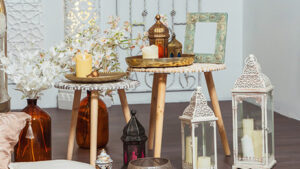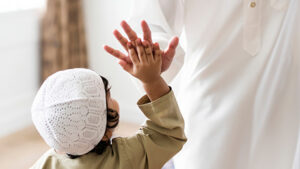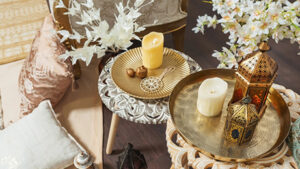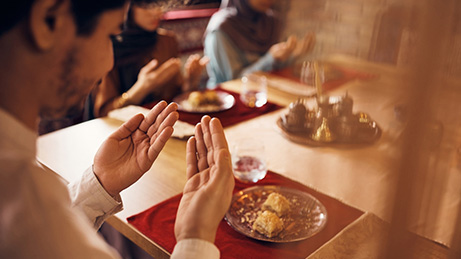Ramadan is the auspicious 9th month of the Islamic Calendar. Muslims all over the world observe this month by fasting and praying. The practice of fasting during the month of Ramadan is a fundamental practice observed by all Muslims. The Islamic calendar determines the first and last dates of Ramadan, which considers the lunar calendar. Fasting from dawn to dusk is mandatory for all Muslims unless they are traveling, elderly, breastfeeding mothers, menstruating, diabetic, or suffering from a chronic illness. During the fasting period, the people keeping Ramadan start their day with suhur, which is the pre-dawn meal, and end their day at dawn with a feast called iftar.
With Ramadan approaching, it is critical that we prepare ourselves and create an atmosphere in our homes that reflects this holy season. This month is all about connecting with God, reflecting on our lives, and expressing gratitude to the almighty. In this article, I will take you through 5 tips for preparing your home for a Ramadan-friendly environment.
Contents
Declutter and Deep-clean your home

It is popularly said that cleanliness is next to godliness. Cleanliness plays a crucial role in creating a welcoming environment. The first step towards cleanliness is decluttering your space of all that is not useful or needed anymore. If there are things like clothes, utensils, books, and fabrics that can be reused, then you can pass them down to someone who would need them or donate them to an organization. Decluttering not only creates a healthy physical space but also a healthy mental space.
Though cleanliness is an important aspect of our day-to-day lives, during Ramadan it is all the more important to deep clean our home and the surrounding space. Decluttering and cleanliness can bring about a change in the physical aura, thereby creating more positive energy in the space.
Decorate your home for Ramadan

Once you have completed decluttering and deep cleaning your home, you can decorate it. Though decorating your space is not mandatory, doing so creates a festive ambiance. You can decorate your home with some DIY crafts, or if you are short on time, you can rent or purchase decorative products. Some ways to decorate your home for Ramadan are as follows:
- Add Ramadan Wreath at your main entrance door.
- Highlight a wall in your living room with “ Happy Ramadan” bunting
- Add traditionally designed lamps at various corners of your house
- Refresh your living room by adding upholstery in colors that will add vibrancy to your house
- Create a prayer space by adding a beautifully designed carpet
- Bring in new tableware for the sumptuous Suhoor & Iftar throughout the month
- Light up the space with star & moon shaped fairy lights
Creating a welcoming environment

Creating a welcoming environment is an important aspect when decorating your home for any festivity or ceremony. Doing so is a combination of visual appeal and usability of things that occupy the space, like furniture or decorative elements. Elements that help you create a welcoming environment at home are:
- Using appropriate lighting to create a welcoming atmosphere
- Use appropriate colors for furnishings & furniture
- Use appropriate decor elements that are relevant to the festive theme of Ramadan.
- Opt for a traditional Arabic setup for Ramadan
- Add fresh aromatic flowers, candles & fragrances to add a wisp of freshness & fragrance to the ambiance.
Comfortable home for a Smooth Ramadan Fasting

Along with taking care of all the physical aspects of creating an appropriate and welcoming environment at home for Ramadan, it is very important to take care of your health during the fasting period of Ramadan to avoid migraines and headaches. You can follow a few simple steps to avoid fasting headaches and migraines during Ramadan:
- Keep the temperature of your home at a degree that is comfortable for your body.
- Use Air purifiers at home to avoid getting lethargic due to pollutants in the air.
- Limit your use of Social media apps. Social media apps are designed in a way that can keep you hooked on them for endless hours, thereby overloading your brain with information. An overload of information can cause mental fatigue, thereby draining your energy.
- Take sufficient hours of naps during the day to keep your body well-rested and avoid fasting fatigue.
Dress appropriately

Dressing appropriately during the month of Ramadan is all about dressing modestly. To dress modestly is to adorn yourself in attire that covers the body appropriately without revealing much of the skin. Modest clothing is all about dressing up in ways that keep unwanted attention at bay. You don’t need to change your wardrobe 360 degrees. Modesty does not mean boring; you can creatively layer up your pieces of clothing to create attire that is appropriate for the festive season. Whatever you choose to wear, make sure it’s comfortable, feminine, and stylish.
Plan your meals & grocery

To avoid any unnecessary burden on yourself, plan your suhoor and iftar meals well in advance. You can create a weekly menu for suhoor and iftar and purchase your groceries accordingly. Planning your meals well in advance saves time, requires less last-minute effort when running errands, and, above all, gives you more time and space for other tasks.
Make this Ramadan even more special by creating a special ambiance at home. The tips mentioned above won’t only help you create a visually appealing atmosphere but will also bring in the festive energy with more vigor. You can look out for a range of furniture, decor, and meal options at Hafla. You can be assured of quality products and services at affordable prices at Hafla.
FAQ
How many days is ramada?
The start and end of Ramadan depend on the sighting of the crescent moon. Generally, it lasts for 29 or 30 days.
Written By: Nitya Gupta
